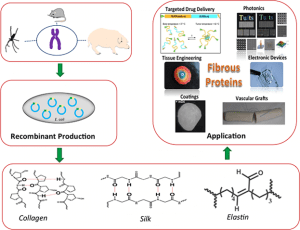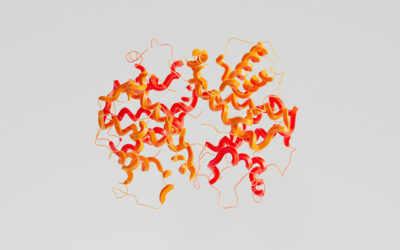Silk, elastin and collagen are naturally occurring fibrous proteins with a tremendous potential in biomaterial systems for tissue repair and regeneration, drug delivery cargoes, and industrial applications to create biologically inspired materials for non-human use. Biosynthetically engineered fibrous proteins have an advantage over synthetic polymers because their natural origin allows bioengineers to tailor their sequence, protein size, degradation pattern, and mechanical properties to their specifications and create a larger variety of commercially produced biomaterials.
In this Biotechnology and Bioengineering review, David Kaplan and co-workers at the Tufts University Department of Biomedical Engineering discuss “recent advances in understanding the fundamental basis of structure-function relationships and the designs that foster fibrous protein self-assembly towards predictable architectures and properties for a range of application”.
 Kaplan and colleagues begin their review by outlining the current challenges of recombinant production of fibrous proteins in microbial host organisms, including the compatibility issues between large proteins derived from mammalian and insect hosts and microbial expression systems. Repetitive nature of the genes encoding fibrous proteins and limitations of the microbial genomic DNA expression systems lead to error prone cloning, resulting in smaller amounts of low-quality products being produced in these hosts. Combined with insufficiently optimized biotechnological platforms and purification approaches, these shortcomings halt the large-scale production of these high-value biomaterials.
Kaplan and colleagues begin their review by outlining the current challenges of recombinant production of fibrous proteins in microbial host organisms, including the compatibility issues between large proteins derived from mammalian and insect hosts and microbial expression systems. Repetitive nature of the genes encoding fibrous proteins and limitations of the microbial genomic DNA expression systems lead to error prone cloning, resulting in smaller amounts of low-quality products being produced in these hosts. Combined with insufficiently optimized biotechnological platforms and purification approaches, these shortcomings halt the large-scale production of these high-value biomaterials.
Next the authors discuss state-of-the art technologies designed to circumvent these challenges. For example, designing synthetic genes and Recursive Directional Ligation (RDL) are aimed to overcome the issues of gene size and errors that occur during replication, transcription and translation in E. coli and other microbial host organisms. Engineering endotoxin-free microbial strains and strains with stress-induced expression, and customizing biotechnological platforms and purification technologies for each type of fibrous proteins are next logical steps in their successful bio-industrialization.
Kaplan and co-workers conclude their review by pinpointing the importance of biosyntethic fibrous proteins for the future of biomedicine and bioengineering. They write, “Overcoming the synthesis related problems and creating the next generation of protein-based materials mimicking existing biopolymers with signaling properties and matching mechanical characteristics with green production are now possible. The exploitation of self-assembly and functionalization of the recombinant biopolymers are guiding tissue engineering into new and important solutions.”
















